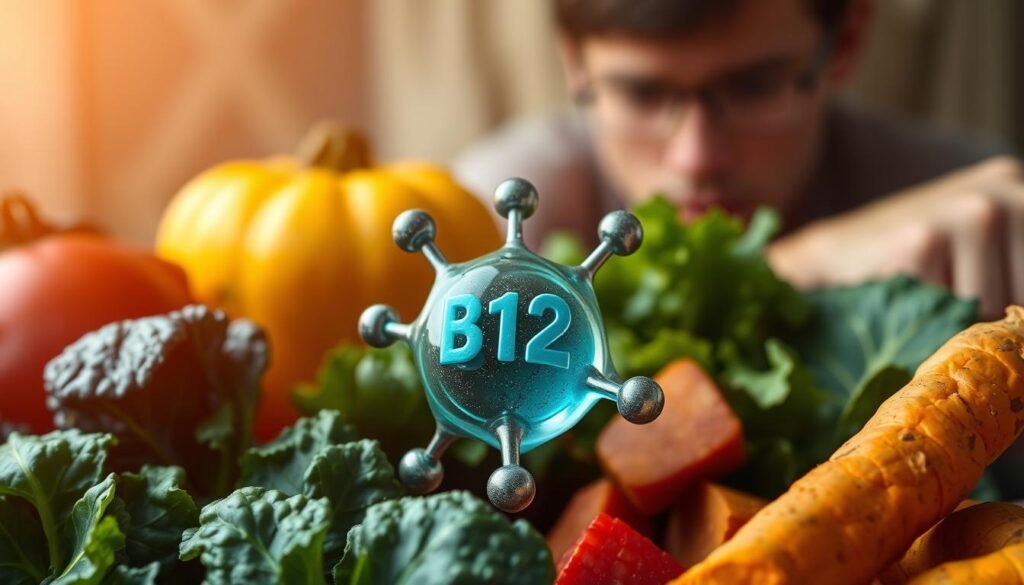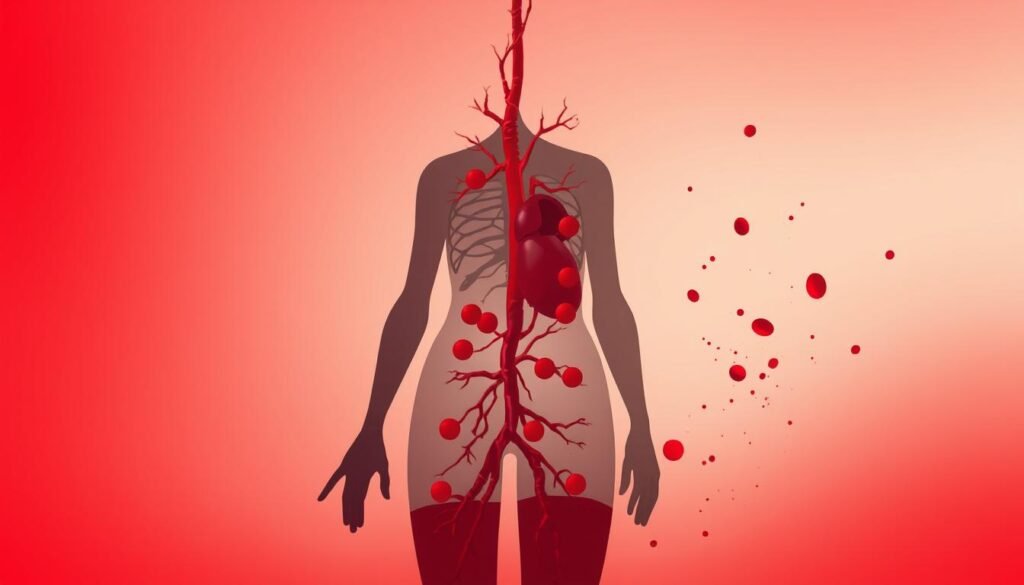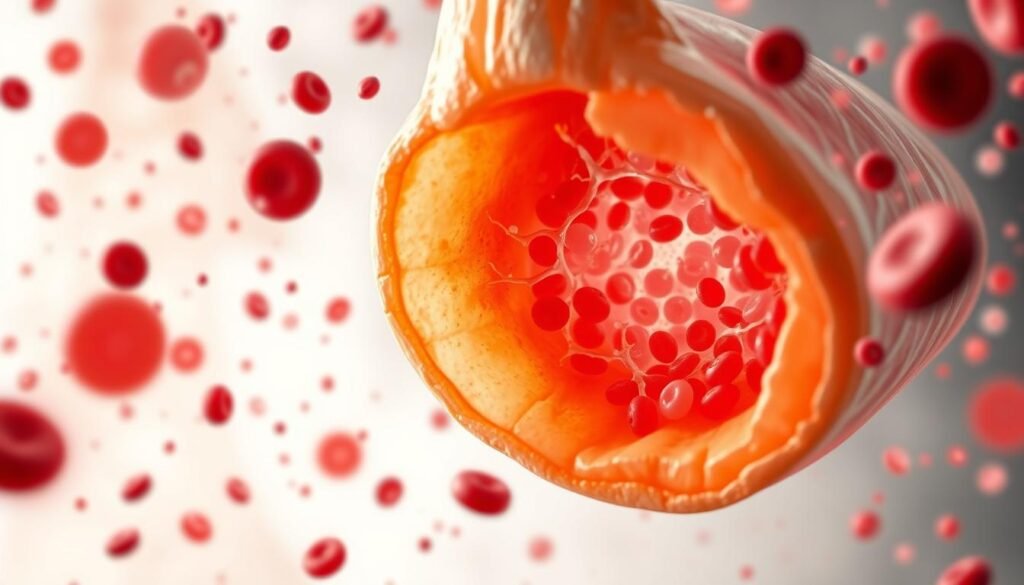Ever felt tired for no clear reason? It might be more than just exhaustion. Knowing the causes of anemia is key to keeping your health on track. Anemia means your body can’t carry enough oxygen in your blood. This is often because you don’t have enough red blood cells. In this section, we’ll look into what triggers anemia and its risk factors. This knowledge can help you avoid or manage this condition.
Key Takeaways
- Anemia significantly impacts public health.
- Recognizing early symptoms is vital for diagnosis.
- Understanding anemia triggers can aid in prevention.
- Risk factors vary among different populations.
- Education about anemia can lead to better health outcomes.
Understanding Anemia: A Brief Overview
Anemia happens when you don’t have enough healthy red blood cells. This means not enough oxygen gets to your tissues. The Anemia Overview explains the different types of anemia and how they affect your health.
What is anemia? It’s often caused by too much blood loss, not making enough red blood cells, or losing them too quickly. Knowing how anemia affects your body helps with quick diagnosis and treatment. The main Anemia symptoms are:
- Fatigue
- Weakness
- Pallor
- Shortness of breath
- Dizziness
Anemia can happen to anyone, at any age, making it important for everyone to know about it. Many people around the world have anemia. This highlights the need for more awareness and education. Eating right, making healthy life choices, and seeing a doctor can help manage and prevent anemia.
| Anemia Type | Common Causes | Prevalence |
|---|---|---|
| Iron Deficiency Anemia | Lack of iron in diet, blood loss | Most common type |
| Vitamin B12 Deficiency Anemia | Poor diet, absorption issues | Common in vegetarians |
| Aplastic Anemia | Bone marrow failure, toxins | Rare but serious |
What Causes Anemia?
Anemia happens when red blood cells or their hemoglobin levels drop. It comes from many factors. Knowing the types of anemia helps understand its causes. There are different kinds, each with its own reasons. Learning about them can help manage and prevent anemia better.
Types of Anemia
Some common types of anemia include:
- Iron deficiency anemia: This kind is most common and happens when you don’t have enough iron.
- Vitamin B12 deficiency anemia: Missing this important vitamin stops red blood cells from forming right.
- Anemia of chronic disease: Long-term health problems can cause this type through inflammation.
- Aplastic anemia: This rare form happens when the bone marrow doesn’t make enough red blood cells.
Prevalence in Different Populations
Anemia affects different groups of people in various ways. Age, gender, and ethnic background play big roles in risk levels:
| Demographic Group | Anemia Prevalence (%) |
|---|---|
| Women (reproductive age) | 15-25 |
| Pregnant women | 30-40 |
| Men | 5-15 |
| Children under 5 | 20-30 |
| Older adults | 10-20 |
Iron Deficiency: The Most Common Cause
Iron deficiency is the top reason people get anemia. It stops the body from making enough hemoglobin. When iron is low, we don’t produce enough red blood cells, leading to health issues. Knowing the signs of iron deficiency anemia is key to fixing it early. This knowledge helps people get the right help and improve their diet.
Symptoms of Iron Deficiency Anemia
Signs of iron deficiency anemia can be mild or severe, including:
- Fatigue
- Dizziness
- Pale skin
- Shortness of breath
- Cold hands and feet
These symptoms mean the body may not get enough oxygen, which red blood cells provide. Watching for these signs is important for catching and treating the issue early.
Sources of Iron in Diet
Eating foods rich in iron is key for keeping iron levels up. Great sources of iron include:
| Food Source | Iron Content (mg per 100g) |
|---|---|
| Red Meat | 2.7 |
| Beans | 2.9 |
| Fortified Cereals | 4.6 |
| Leafy Greens | 2.5 |
A balanced diet with these foods can really help fight iron deficiency. By choosing wisely, people can avoid anemia and stay healthy.
Vitamin B12 Deficiency and Its Impact
Vitamin B12 is crucial for making red blood cells and for brain health. Not getting enough can cause severe health problems. This can lead to pernicious anemia, a dangerous type of anemia.
Being deficient in Vitamin B12 can make you very tired, affect your mood, and cause nerve problems.
Consequences of Vitamin B12 Deficiency
Vitamin B12 deficiency can harm many parts of the body. Some common symptoms are:
- Extreme fatigue
- Shortness of breath
- Dizziness
- Cognitive difficulties
- Neurological issues, including tingling or numbness
It’s important to know how Vitamin B12 deficiency affects health. This can help us choose what to eat better. At higher risk are pregnant women, the elderly, and people with certain illnesses.
Learn about symptoms and causes at this page.
Dietary Sources of Vitamin B12
To avoid a Vitamin B12 shortage, it’s essential to eat the right foods. You should eat:
- Meat (especially liver and fish)
- Dairy products (milk, cheese, yogurt)
- Eggs
- Fortified foods such as cereals and plant-based milk
For vegetarians and vegans, getting enough Vitamin B12 can be hard. They need to carefully choose their food and might need supplements. Learn more about managing Vitamin B12 levels here.

Chronic Diseases Contributing to Anemia
Chronic diseases have a big impact on anemia. Health issues like chronic kidney disease, cancer, and autoimmune disorders can make it hard for the body to make red blood cells or absorb nutrients. These are some of the top conditions that cause anemia.
These diseases can change hormone levels that are needed for making red blood cells. For example, chronic kidney disease can lower the amount of erythropoietin, which is crucial for creating red blood cells. Likewise, cancers may mess up the normal production of these cells. And autoimmune disorders could destroy them, making anemia worse.
When anemia is caused by chronic illnesses, it can really affect someone’s life. It’s important to deal with these health problems to manage anemia better. Below is a table that shows some common chronic diseases and how they are linked to anemia.
| Chronic Disease | Mechanism Linked to Anemia |
|---|---|
| Chronic Kidney Disease | Decreased erythropoietin production affecting red blood cell synthesis |
| Cancer | Impaired blood cell production due to cancerous growths |
| Autoimmune Disorders | Destruction of red blood cells or inflammation affecting production |
| Diabetes | Complications can lead to reduced blood flow and nutrient absorption |
| Chronic Infections | Inflammation affecting iron metabolism and red blood cell production |
The Role of Blood Loss in Anemia
Blood loss is a key factor in Blood Loss Anemia. Understanding the Causes of Blood Loss is crucial for grasping its impact on health. We’ll look at usual sources of blood loss and its effects on people.
Common Causes of Blood Loss
- Heavy menstrual periods, which can lead to chronic anemia in women.
- Gastrointestinal bleeding caused by ulcers, polyps, or hemorrhoids.
- Trauma resulting from accidents or injuries.
- Post-surgical losses, where blood may drain during operations.
Effects on Overall Health
Excessive blood loss leads to serious Health Effects of Blood Loss, greatly affecting one’s well-being. Some effects include:
- Rapid heart rate as the body tries to make up for less blood.
- Dizziness or fainting due to low blood pressure.
- Fatigue as the body works hard to keep oxygen levels up.
- In severe cases, shock may happen, needing quick medical help.

Inherited Disorders: Genetic Factors
Inherited Disorders are crucial in anemia’s development. Some genetic factors change how we make hemoglobin and red blood cell life. Sickle cell disease and thalassemia are types of Genetic Anemia, affecting millions around the globe.
To have a disorder like this, both parents must usually pass on a faulty gene. If only one parent carries the gene, the child might carry it too. But, they won’t show any signs of the disorder.
| Genetic Anemia Type | Mode of Inheritance | Key Characteristics |
|---|---|---|
| Sickle Cell Disease | Autosomal Recessive | Abnormal hemoglobin causing red blood cells to become sickle-shaped, leading to pain and organ damage |
| Thalassemia | Autosomal Recessive | Reduced production of hemoglobin, resulting in anemia of varying severity |
Early diagnosis and genetic counseling are very important. They help families understand Anemia’s Genetic Factors. This knowledge leads to better care and support, making life better for those affected.
Bone Marrow Problems as Underlying Causes
Bone marrow is crucial for making blood cells, like red and white blood cells, and platelets. Disorders can disrupt this process, leading to fewer blood cells being made. It’s important to know about these disorders because they can cause anemia.
Types of Bone Marrow Disorders
Many conditions can impact bone marrow and our health. Here’s a quick look at some common ones:
- Aplastic Anemia: This rare disorder stops the marrow from making enough blood cells. It can lead to anemia, infections, and bleeding problems.
- Myelodysplastic Syndromes: These are disorders where the blood cells are poorly formed or don’t work right. This can cause anemia as the cells don’t mature correctly.
- Leukemia: This cancer affects the blood and bone marrow, creating too many abnormal white blood cells.
- Myelofibrosis: A serious problem where the marrow can’t make blood cells properly, causing anemia and other issues.
Keeping in mind these bone marrow issues is key when looking at anemia causes. They directly impact the blood cell levels in our body.

Medication Side Effects Leading to Anemia
Some medicines can cause serious Medication Side Effects, like anemia. They might stop red blood cells from forming right or make them die too soon. This lowers the number of red blood cells. It’s crucial to know about Drugs Causing Anemia and to watch your health while on these medicines.
NSAIDs and certain antibiotics are often to blame. They can lead to autoimmune problems and more bleeding, making anemia worse. Talking to your doctor can lower the risks tied to Anemia Due to Medication.
Checking your medicine often can help stop problems. If you feel tired or look yellow, get help right away. Getting help early can fix the anemia and might mean you don’t need the medicine anymore.
For more info on how medicines can cause anemia, check this resource. Knowing about these risks lets you better manage your health and talk to your doctor.
Heavy Periods: A Common Risk Factor
Heavy menstrual bleeding, or menorrhagia, impacts women’s health a lot. It’s usually a concern for premenopausal women. This condition can lead to serious issues like Menstrual Anemia. This happens because of too much blood loss when menstruating.
When heavy periods go on, they might lower the body’s iron levels. This increases the chance of getting anemia. It’s important to understand what makes heavy periods a risk factor for anemia.
Some causes of menorrhagia are uterine fibroids, polyps, and hormonal imbalances. Other medical conditions can also lead to heavy bleeding. It’s vital to find out the cause to treat the symptoms well.
Women with heavy periods should talk to doctors. There are different treatments available, such as medication and hormonal therapies. These treatments help reduce the bleeding and ease Menstrual Anemia’s symptoms. Learning about and understanding menstrual health helps women take charge of their conditions.
For more details on heavy menstrual bleeding and its impacts, you can check out this resource.
Poor Nutrition and Its Role in Anemia
Poor nutrition increases the risk of anemia. Anemia from poor nutrition happens when you don’t eat enough essential nutrients. Important nutrients like iron, vitamin B12, and folate are needed for healthy red blood cells. If you don’t get enough, your body can’t keep your blood healthy. This leads to anemia.
It’s important to understand how nutrition affects anemia to prevent it. Eating a balanced diet can lower anemia risks. Foods rich in iron, B12, and folate are key to avoiding the impacts of bad nutrition.
To keep your red blood cells healthy, add these nutrients to your meals:
- Iron: Found in red meat, beans, lentils, and spinach.
- Vitamin B12: Present in meat, fish, dairy products, and fortified cereals.
- Folate: Located in leafy greens, citrus fruits, and whole grains.
Raising awareness of how poor nutrition leads to anemia helps people make better food choices. Highlighting the importance of nutrition can lead to healthier lives and better health overall.
| Nutrient | Sources | Recommended Daily Allowance (RDA) |
|---|---|---|
| Iron | Red meat, beans, lentils, spinach | 8 mg (men), 18 mg (women) |
| Vitamin B12 | Meat, fish, dairy, fortified cereals | 2.4 mcg |
| Folate | Leafy greens, citrus fruits, whole grains | 400 mcg |
Addressing poor nutrition helps prevent nutritional anemia and supports overall health. Knowing these links can lead to healthier eating habits and a better future.
Conclusion
It’s important to know about Anemia and what causes it. There are many reasons a person might get Anemia. It can be due to not having enough iron, missing certain vitamins, long-term illnesses, or inherited conditions. Everyone is different, so it’s key to pay attention to what your body needs.
If you think you might have Anemia, it’s crucial to talk to a doctor. They can help figure out if you do and what you should do about it. Treating Anemia usually means eating differently, taking vitamins, and going to the doctor regularly. These actions help people get back their energy.
Learning about Anemia and keeping an eye on your health can change your life. If you understand what causes it and do something about it, you can feel better. Fighting Anemia helps people improve their health and face fewer problems from this common issue.